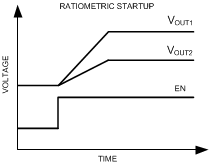SNVS633K January 2010 – April 2019 LMZ10505
PRODUCTION DATA.
- 1 Features
- 2 Applications
- 3 Description
- 4 Revision History
- 5 Pin Configuration and Functions
- 6 Specifications
- 7 Detailed Description
- 8 Application and Implementation
- 9 Power Supply Recommendations
- 10Layout
- 11Device and Documentation Support
- 12Mechanical, Packaging, and Orderable Information
Package Options
Mechanical Data (Package|Pins)
- NDW|7
Thermal pad, mechanical data (Package|Pins)
Orderable Information
7.3.6 Tracking - Equal Soft-Start Time
One way to use the tracking feature is to design the tracking resistor divider so that the master supply output voltage, VOUT1, and the LMZ10505 output voltage, VOUT2, both rise together and reach their target values at the same time. This is termed ratiometric start-up. For this case, the equation governing the values of tracking divider resistors Rtrkb and Rtrkt is given by:

The above equation includes an offset voltage, of 200 mV, to ensure that the final value of the SS pin voltage exceeds the reference voltage of the LMZ10505. This offset will cause the LMZ10505 output voltage to reach regulation slightly before the master supply. For a value of 33 kΩ, 1% is recommended for Rtrkt as a compromise between high precision and low quiescent current through the divider while minimizing the effect of the 2-µA soft-start current source.
For example, if the master supply voltage VOUT1 is 3.3 V and the LMZ10505 output voltage was 1.8 V, then the value of Rtrkb needed to give the two supplies identical soft-start times would be 14.3 kΩ. Figure 19 shows an example of tracking using the equal soft-start time.
 Figure 19. Timing Diagram for Tracking Using Equal Soft-Start Time
Figure 19. Timing Diagram for Tracking Using Equal Soft-Start Time